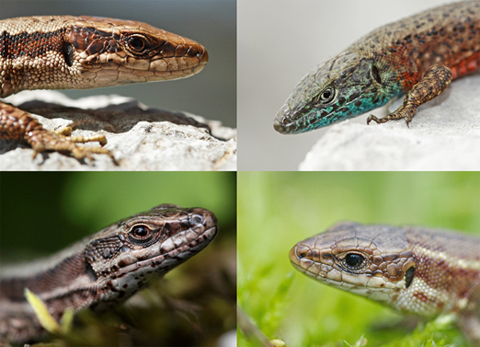Dr. Donald Miles, Professor of Biological Sciences at Ohio University, contributed to a study that shows that even sun-loving lizards may not survive rising temperatures in their environment.
Climate change is toppling our Earth’s ecosystems out of balance in multiple ways, with often dramatic consequences. Many plants and animals are already impacted. But surprisingly, it is only poorly understood which are the specific threats, and how the actual consequences will look like.
Lizards are a group of animals that proverbially love the sun (they are called “heliotherms”). Because these are cold-blooded animals, they depend on warmth and solar radiation to attain the temperatures they like. So the obvious hypothesis would be that they will benefit from global warming. But will they?

Four species of lizards from Slovenia included in the study. From top left to bottom right: the Velebit lizard (Iberolacerta horvathi), the Dalmatian Algyroides lizard (Algyroides nigropunctatus), the Common wall lizard (Podarcis muralis) and the Viviparous lizard (Zootoca vivipara). Photos by Miha Krofel.
A team of 45 researchers from 17 countries has now come closer to answering this question in a study “Environmental temperatures shape thermal physiology as well as diversification and genome-wide substitution rates in lizards” published Sept. 9 in Nature Communications.
The researchers focused on the physiology of the so-called lacertid lizards, a group that is widespread in Europe, Asia and Africa.
Lacertid lizards contain species occurring in the blazing heat of the Namib desert, but many others are restricted to chilly habitats on mountains above 2000m in Europe. One of them, the viviparous lizard, even reaches the Arctic Circle, farther north than any other reptile.
The study experimentally determined which temperature lacertid lizards prefer, and how tolerant they are against water loss in arid conditions, against the backdrop of their evolutionary tree. It was known that lizards in tropical environments often operate at temperatures very close to those of the environment, and this was not different in tropical lacertids — when climate change leads to a temperature increase in their environment, they may not be able to persist.
“We found in these lizards a strong adjustment between physiology and environmental temperature, and this likely makes them very sensitive to global warming” says Joan Garcia-Porta, researcher at the Centre for Research on Ecology and Forestry Applications, CREAF, Spain and currently at Washington University in St Louis, USA, the first author of this study.
But what about lacertids in temperate environments? Based on newly compiled physiology data of over 50 species, the researchers found that much of their biology is equally determined by climate.
“It was amazing to discover how neatly these species are adapted to their environment. Their physiology, size of distribution ranges, species richness, and even mutation rates – everything correlates strongly to the temperatures they experience in the wild,” commented Miguel Vences, a co-author and professor of evolutionary biology at the Braunschweig University of Technology.
The study used state-of-the-art DNA sequencing methods and analyses of fossils to reconstruct the evolution of 262 species of lacertid lizards. According to Iker Irisarri, a researcher at the Spanish Research Council CSIC in Madrid who contributed to these analyses: “These animals in Europe have been the focus of hundreds of studies over the last years. Our new genomic analyses finally ascertained how they relate to each other in evolutionary terms, and when they originated.”
Glimpsing into the past of lacertid evolution showed that many of them originated in warm past climates, but since then they have adapted as the Earth cooled down, and spread into very cold regions in the process.
“The story of non-tropical lacertids is one of persistence against cold. There has been no precedent in their evolution to cope with either heat or with dry conditions for millions of years,” says Katharina Valero, a lecturer at the University of Hull, UK.
Confirmation of the study’s hypothesis comes from the perhaps most cool- and moist-loving viviparous lizard.
“Populations in the Pyrenean Mountains where environmental temperatures come close to their preferred temperatures are already extinct – a presage of what might happen with other lizards,” says Barry Sinervo, a professor at University of California at Santa Cruz who has been studying lizard declines for over 10 years.
Miguel-Angel Carretero, a lizard specialist at CIBIO institute, Portugal, adds: “The mechanisms by which these lizards decline are complex, but we start to understand them better. Warmer temperatures also mean lower humidity, and climate change forces these lizards being active in dry environments that they cannot cope with.”
Miles’ role involved assembling data from the long-term study of the common lizard in France (along with Barry Sinervo, also a coauthor of the paper). “I also was involved with the fieldwork completed in Namibia with Sebastian Kirchhof and helped with the writing of the manuscript,” he notes.
This will affect lizards in many regions of Europe.
Anamarija Žagar, researcher at the National Institute of Biology in Slovenia, warns: “There are two species of lizards living in Slovenia that are adapted to cool and wet environments, the Velebit lizard that lives in Alpine and Dinaric mountain area and the Viviparous lizard, also characteristic to mountains, as well as lowland marshlands. According to our study, both species are likely to be the most affected by changes in climate. But even more importantly, our results also suggest that similar processes could negatively influence other ectotherm species. Slovenia is considered a biodiversity hot-spot of Europe and represents important habitat for many ectotherm species that are specialized to live in cool environments. These species will soon disappear if we do not enhance our efforts to mitigate climate change soon, while consequences of biodiversity loss are known to affect the whole ecosystem.”
This will affect many European regions including Iberian Peninsula. Miguel A. Carretero, Anamarija Žagar and James Harris, CIBIO-InBIO members and co-authors in the study, warn: “The amazing diversity of Iberian lizards consist of a mixture of species adapted to cool-wet and to hot-dry environments, many of them unique. According to the study, the first ones, such as the rock lizards found in the mountain tops and the Atlantic Carbonell’s lizard and the Valverde’s lizard will be the most exposed to global change. But even more importantly results also suggest something similar could be true to other ectotherm (“cool-blooded”) species. As such, the Iberian biodiversity hot-spot will become too hot for those species specialized to live in cool environments. These will gradually decline and disappear if we do not enhance our efforts to mitigate climate change soon. Such irreparable biodiversity loss will have unpredictable consequences for the whole ecosystem.”
While the study provides conclusive data on many species of lacertids occurring in Europe, those members of this group in other parts of the globe will still require more attention in the future.
The team of Prof. Johannes Müller at the Natural History Museum in Berlin, Germany, has been working for many years on the lacertids of Africa, noting, “Interestingly, only one of over 20 species of lacertids living in extremely hot and arid habitats in the Namib and Kalahari Deserts show signs of potential warming-related extirpations.”
Sebastian Kirchhof, a researcher affiliated to the Berlin museum, adds: “But it is largely unknown what happens to those species adapted to cool and moist environments in Africa, and it will be important to direct future research to these species.”
Authors: Joan Garcia-Porta*, Iker Irisarri*, Martin Kirchner, Ariel Rodríguez, Sebastian Kirchhof, Jason L. Brown, Amy MacLeod, Alexander P. Turner, Faraham Ahmadzadeh, Gonzalo Albaladejo, Jelka Crnobrnja-Isailovic, Ignacio De la Riva, Adnane Fawzi, Pedro Galán, Bayram Göçmen, D. James Harris, Octavio Jiménez-Robles, Ulrich Joger, Olga Jovanović Glavaš, Mert Karış, Giannina Koziel, Sven Künzel, Mariana Lyra, Donald Miles, Manuel Nogales, Mehmet Anıl Oğuz, Panayiotis Pafilis, Loïs Rancilhac, Noemi Rodríguez, Benza Rodríguez Concepción, Eugenia Sanchez, Daniele Salvi, Tahar Slimani, Abderrahim S’khifa, Ali Turk Qashqaei, Anamarija Žagar, Alan Lemmon, Emily Moriarty Lemmon, Miguel Angel Carretero, Salvador Carranza, Hervé Philippe, Barry Sinervo, Johannes Müller, Miguel Vences, Katharina C. Wollenberg Valero


















Comments